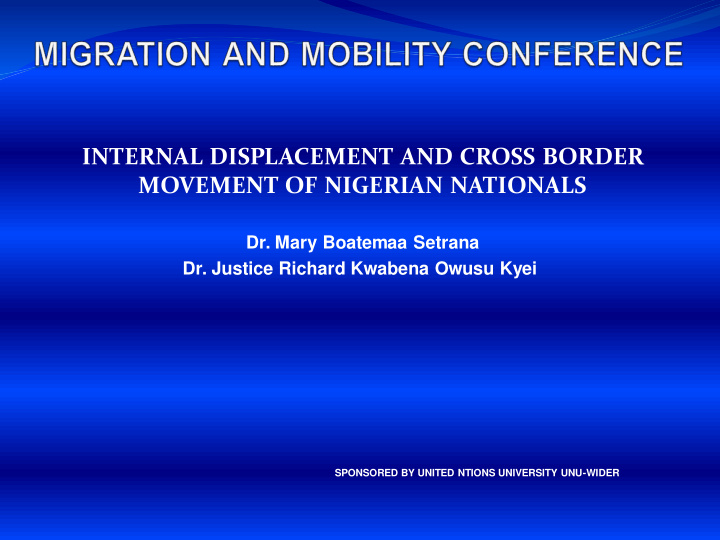



INTERNAL DISPLACEMENT AND CROSS BORDER MOVEMENT OF NIGERIAN NATIONALS Dr. Mary Boatemaa Setrana Dr. Justice Richard Kwabena Owusu Kyei SPONSORED BY UNITED NTIONS UNIVERSITY UNU-WIDER
Introduction Purpose of Presentation To examine internal displacement and the subsequent cross border movement within the ECOWAS Sub-region. It also examines the genderedness of internal displacement in Nigeria Data and Methods Secondary and primary data sources: government and non-governmental organisations’ reports and newspapers; Content Analysis, document analysis Outline of Presentation Forced migration; Typologies of internal displacement; Cross-border movement vis-à-vis ECOWAS Treaty on free movement; and conclusions
Definition of Key Concepts Forced mobility is defined here as: a migratory movement in which an element of coercion exists, including threats to life and livelihood, whether arising from natural or man-made causes (example movements of refugees and internally displaced persons as well as people displaced by natural or environmental disasters, chemical or nuclear disasters, famine, or development projects) (IOM, 2004:25). United Nations Guiding Principles on IDPs in 1998 defines IDPs as: Persons or groups of persons who have been forced or obliged to flee or to leave their homes or places of habitual residence, in particular as a result of or in order to avoid the effects of armed conflict, situations of generalized violence, violations of human rights or natural or human-made disasters, and who have not crossed an internationally recognized State border (1998:5).
Forced Migration of Internal Displacement in Nigeria Internal Displacement Forced Mobility Cross Border Movement
Typologies of Internal of Displacement in Nigeria Climate Change Terrorist attacks Forced Eviction and Ethno- • Flooding religious Conflicts • Desertification • Government Developmental Projects • Boko Haram • Ethnic Conflicts
Table 1: Internal Displacement caused by flood in Nigeria (2009- 2012) Year Affected Population 2009 140,000 2010 560,000 2011 6,300 2012 6,112,000 Total 6,818,000
Gendered Impacts Displacement is not free from gender bias Most of the few IDPs data overlook the gender embedded nature of internal displacement in Nigeria
The Linkage and Assessment of Cross Border Movement of IDPs and the 1979 ECOWAS Protocol The ECOWAS protocol on free movement of persons, residence and establishment was enacted in May 1979 by all member countries. The protocol did set out a three phased approach over a period of 15 years to allow the right to entry and abolition of visas; free residence; and right to establishment (Adepoju, 2008)
Conclusion and Key Research Gaps The paper has argued that inasmuch as some Nigerians migrate voluntarily, there are others who are forced to move internally Some of the IDPs who move beyond the national borders lack basic legal and humanitarian support as they do not qualify as refugees neither are they protected under any international law Gender is embedded in internal displacement and recommends that future research should not overlook the gender bias Significant obstacles in the ECOWAS protocol against free mobility within the sub-region The research also concludes that internal displacement is not always transient as a result sustainable and income generating trainings may contribute to the wellbeing of IDPs
THANK YOU
Recommend
More recommend